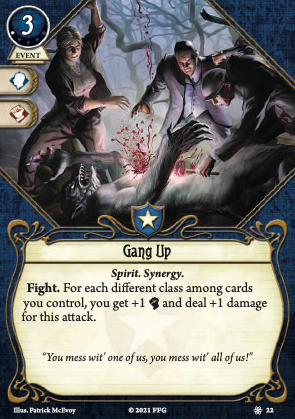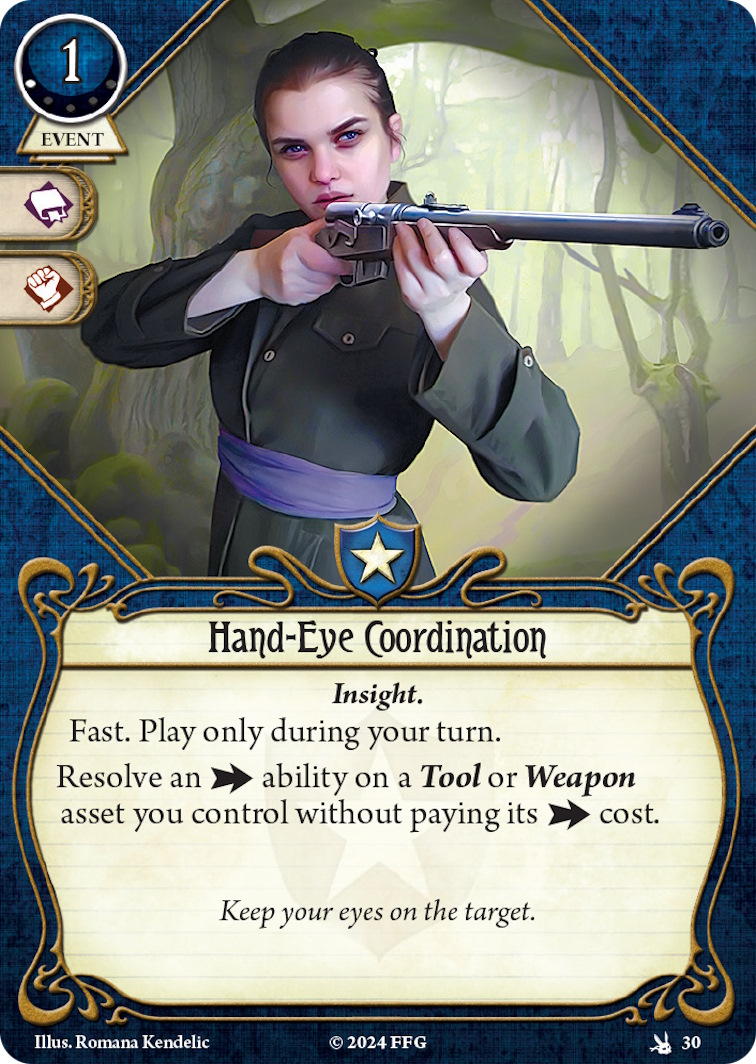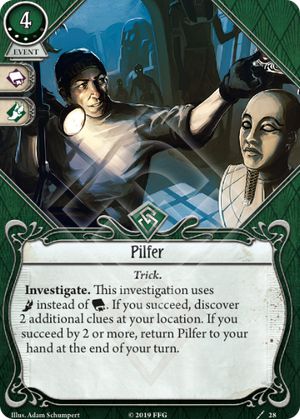
I saw lots of discussion about this card and while some people think it's great, most say it's extremely average. Personally, I think it's incredible, especially at what it does for Rogues who just wanna rogue. The last expansion was Dirty Fighting and how it made lots of Rogues great fighters, but this expansion it’s British Bull Dog and its pure simplicity. This inspired me to go deeper into this card and here I post.
British Bull Dog level 0 looks very similar to Shrivelling for Mystics. Shrivelling is a good card that goes into fighting or flex Mystics that just want to do damage. Its main pro is 4 charges that can use willpower to attack, which is quite a lot for that cost and level 0. It can be cheated in, it can be recharged, Mystic’s Willpower can be buffed to the R’lyeh and back, there are other assets, events and skills that can easily be comboed into Shrivelling, it quickly becomes dangerous.
But despite their similarities, BBD has completely different uses in my opinion. It turns your agility into an attack stat for 3 strong attacks. It’s simple. It’s reliable. It offers safety. It’s a great card to add to any deck that doesn’t focus on fighting at all and instantly make it better. It also has a secondary effect, but just ignore it for a moment, as you should for 90% of your games.
Let’s analyze what British Bull Dog says on its card:
- 3 resource cost – Like Shrivelling, BBD costs 3 resources. That’s not nothing, but for a class that focuses on resources, 3 for 3 shots is quite a bargain imho. Mystics have gotten quite a lot resource generation through the years, but Rouges are the kings here. Let's not even talk about Emergency Cache, Bank Job or Faustian Bargain. Even a crappy card like Dario El Amin can give you 2 resources for an action, which is enough to play BBD with the one resource you get from upkeep. Not only that, but most other Rogue weapons that give you +1 damage are more expensive. .25 Auto and Mauser C96 are both 4 resources and .45 Thompson is 6. .41 Derringer costs the same, but its damage is just not as reliable. Knuckleduster is cheaper, but it’s useless in any deck that doesn’t just directly build for fighting and tanking, and Switchblade level 0 is just not that good if you don’t build around it and combo it with something crazy, like Tony.
- Level 0 – Being level 0 makes this card a simple include in anyone that wants it. Not only every Rogue, but also other investigators, mainly Wendy and I’d bet it’s also gonna be the upcoming Seeker Lucius Galloway. It’s also a possible target for Versatile and while I’m not sure that’s the best idea, I also think that Versatile is a very underrated card. I’m surely not the first who thought about putting a BBD into Rita Young, since she has access to deck thinners like Short Supply and crazy boosters like Track Shoes or Sparrow Mask. I’m not saying that’s the best combo in the world, but it might work as a fun starting idea for a thematic deck.
- 3 ammo – Compared to other guns in the game, 3 resources for 3 ammo that do +1 damage is perfectly fair. You also have 3 actions in one round and you can use BBD for the entire 3 actions, which is not nothing considering you can instead throw BBD in with Sleight of Hand and have a turn of being a fighter for free. Compared to Shrivelling’s 4 charges, 3 ammo is less and feels less, but you also have many ways to reload or replay BBD, as well as you just don’t need that much ammo if you won’t be the main fighter. Ammo’s not a bargain like Mauser C96, but it doesn’t have to be because...
- ...British Bull Dog uses agility for your attack stat. That was previously available on a few cards, but non-campaign reward weapon was mainly Ornate Bow. And that’s extremely expensive in terms of resources, XP, as well as requires 2 hands to wield and recharge ammo. Ornate Bow is a superb weapon in the right deck, but that’s an entire deck built around it. British Bull Dog just is. This is not only agility added on top of your combat, but your agility becomes combat for that action. That also means you can throw in some commits from other, completely non-fighting agility cards if you want to. You can also use cards that would otherwise be used for evading, just to throw them at the enemy instead. You don’t need resources anymore? Throw in a Sneak By. You don’t have to move anymore? Scout Ahead has 2 agility icons. Agility icons are by far the most frequent on Rogue cards, so this makes for another way to use them.
- If an enemy has lots of fight value, you'd evade it with agility anyways. If it has lots of fight, just evade it and leave it for your fighter. If it has everything, you can try commiting to fight it off. And if it has lots of everything, what are you doing here and where is your fighter who should be here instead of you? You can try and help doing damage too if you want, but you're not the main fighter.
- Even more, if you really wanna fight and want to do more damage, you would surely look at a weapon that uses combat, so you can use damage boosts on that. That is very good, but requires combat icons and Guardian or Survivor access. British Bull Dog just is. It doesn't give you any boosts at level 0, but you already have a high agility stat you're not using for combat. Why try and waste precious actions on boosting combat if you'll only need it for a few enemies, or maybe you won't even need it? Just pull out your BBD and shoot. It's a great card for you to feel safe and go out on your own, adventuring and completing extra objectives when you could be crying in a corner behind your fighter. Just do it! You could commit to "brick to the head" tactics (Long Shot) if you have access to it and it is also great for a flex Rogue (or Survivior) because it also works on evades and allies' fighting.
- Other than that, agility makes BBD a really good card for other investigators that couldn’t really fight that easily until now. Yes, there’s Backstab that does the same, but ONLY 1 time and there are cards like Sneak Attack, that can do damage to exhausted enemies. But that’s all complicated and requires combos, buildup, resources and everything you don’t have in a normal game of AH. British Bull Dog just is. Why not just have a BBD ready and waiting for a fool to show their head out the door, so you can calmly shoot it off. This makes someone like Monterey actually decent at fighting off a few enemies (with his Whip, he now has 3 weapons in his deck), or even Sefina can try some target practice. Wendy especially benefits from BBD, as it perfectly changes her 1 combat into magical 4, which is quite decent early, especially with boosts and/or commits. Not only that, there are also easy ways to get more agility in any of these decks. Masks and many other boosts are readily available.
- Then there’s the ignored secondary ability. When you fail a skill test while Parleying, play BBD for free. It sounds great, as 0 resources and 0 actions are a sweet combo, but failing a Parley is another story. IF and only IF you have an enemy, a Parley you can fail without much repercussions, this effect is amazing. If you don’t, leave it alone and use it only if it just happens to activate by sheer luck. In Alessanda, this is incredible, in other decks, leave it alone. You can use it to throw in a weapon when you’re engaged, since Parley doesn’t trigger attacks of opportunity, so that’s a plus. You can also intentionally fail a Parley on a story asset or enemy if it won’t hurt you for that action.
- There's also a great upgrade for BBD. It's not game-changing, but +2 agility on attacks can be useful even into the late game. Especially since British Bull Dog (2) is only level 2, which makes it almost as accessible as BBD (0). That makes it a great upgrade option for any previously mentioned investigators, except Monterey Jack, and also Rita who has a myriad of her own upgrade options. But again, upgrading isn't even a problem, since you'd usually just need something extra for starting the game safer. There's lots of options that give you enemy management if you're willing to part with XP for them. On the other hand, if you have BBD and need a better one, 4 XP is a bargain for almost anyone.
The last and the biggest pro is unwritten on the card. That's because BBD does not have any conditions or built in “breaks” written on it. Other level 0 weapons are expensive (.45 Thompson), or they need to overhit (.41 Derringer), or maybe they exhaust after use (Mauser C96). Some are useful only for hitting enemies when they're already down (.25 Auto). These are all good options, but they require thinking ahead and doing somthing else for them to be useful. British Bull Dog just is. This sheer simplicity is what makes this weapon so good in my opinion. You don’t need anything except high starting agility to use it. And rogue agility stats are mostly 4-5. That’s GREAT! This also means that other stats are usually worse, which means they need to be buffed first to use them good. Why does Thieves’ Kit work? It does the same thing and it works because of that. Just makes a stat that can’t be used to defeat enemies into a stat that now can.
Put 2 BBD into a deck, which is only 2 cards and now you have an effective defense against enemies when your fighter is overwhelmed or you’re exploring on your own. Put in 2 Backstabs and 2 Sneak Attacks, a .25 Auto and you’re an extremely effective flex for just 8 cards. You can also throw it in with Sleight of Hand and now you have a turn of shooting almost for free. Now you’re great at fighting and you also have 20 more cards to do with them what you want. Or 28 in the first case. That I think is very valuable and it’s similar to how 2 Wards of Protection shuts down an entire way of encounter deck trying to kill you, or how 2 Peter Sylvestre’s give you an immunity against horror. I don’t think British Bull Dog is the best weapon for fighters, but I think it’s one of the best fighting weapons for non-fighters. Even the art has the Bull Dog sit on a piece of paper with a pen by its side. It's not among trophies, or grenades, or ungodly amounts of ammo. It's just a simple and reliable option a perspective Rogue puts in their pocket just in case. That’s why this weapon is incredible.



